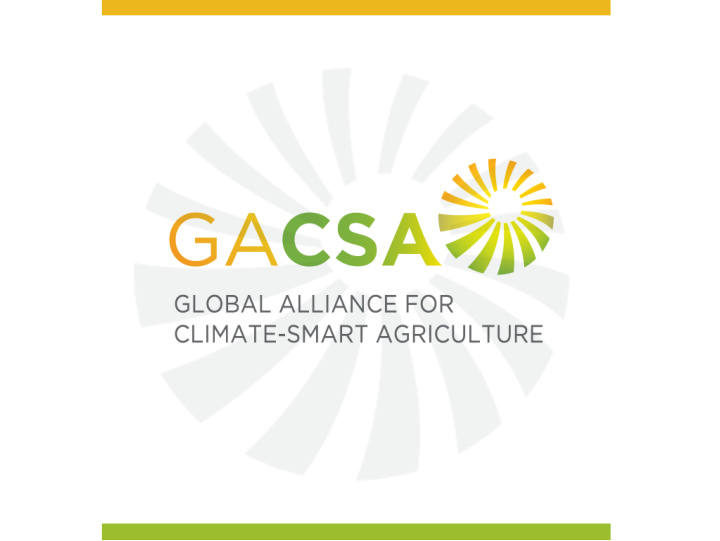



What is GACSA? GACSA is a food security and nutrition focused, agriculture-driven and action-oriented voluntary coalition of entities committed to: incorporating climate-smart approaches, at all scales and types of agricultural systems, across all climates and approaches to farming including crop, livestock, fishery and forestry activities, providing farmers an innovative toolbox of options from which to choose.
GACSA Rationale • Currently one person in eight is suffering from chronic hunger and the world population will exceed 9 billion by 2050, hence need for more food • Huge pressure on natural resources by current food production and consumption patterns, exacerbated by climate change. • Risk of compromising food security and poverty reduction; the most vulnerable to which are small-scale farmers, including livestock keepers, fishers and foresters; especially women, youth and indigenous peoples Need for quick actions to achieve food & nutrition security, and to improve incomes and livelihoods of food producers through: sustainable increases in agricultural productivity; reducing food losses and waste; Improved resilience of all food systems; adaptation of food systems to climate change; reduction /elimination of GHG emissions from agricultural production systems.
GACSA Objectives Primary Focus: • Improve food security and nutrition in the face of climate change by working towards sustainable increases in the productivity of food systems; • Help relevant stakeholders to adapt food system policies and practices to the dictates of climate change and promote efficient and sustainable use of natural resources; Aspirational Outcomes: • Sustainable and equitable increases in agricultural productivity and incomes; • Greater resilience of food systems and farming livelihoods; • Reduction and/or removal of GHG emissions associated with agriculture where possible
GACSA Membership • National governments • intergovernmental entities; • International Organizations, including UN agencies; • Non-Governmental Organizations • Civil Society Organizations; • Research, education, extension and policy bodies / networks; • Farmers organizations; • Financial institutions and funding bodies; • Private businesses .
GACSA Structure • The Annual Forum – High level platform for: Open dialogue, consensus building, priority setting and programme approval; Learning and exchange/sharing of knowledge and information, practices, lessons, opportunities, and results of CSA implementation. • The Strategic Committee, headed by two elected Co-Chairs: Decision authority, guiding & approving work plan and budget of the FU; Oversees implementation of PoW & main activities of the Alliance . • The Facilitation Unit: Secretariat of the alliance, coordinating membership and members’ actions to deliver on the aspirational outcomes; Facilitate resource mobilization and information gathering and dissemination . • Action Groups (Knowledge, Investment, Enabling Environment): Support the implementation of actions of GACSA members to achieving the agreed aspirational goals; Act as the focal point to the Alliance on their respective thematic areas.
GACSA Activities Initial focus Increase & promote translation of knowledge, R&D into Improving the technologies, practices & effectiveness of public policy approaches for CSA; and private investments Knowledge and sharing thereof. that support the three pillars of CSA Enabling Investment Env. Integrating CSA into policy, strategies and planning at Cross-cutting projects, e.g. regional, national, and local Country case studies levels and across landscapes.
Contribution to SDGs SDGs GACSA Objective Goal 1: End poverty in all its forms everywhere Goal 2: End hunger, achieve food security 1. Sustainable and and improved nutrition and equitable increases in promote sustainable agriculture agricultural productivity Goal 12: Ensure sustainable consumption and production patterns Goal 13: Take urgent action to combat 2. Adaptation of food climate change and its impacts systems for greater Goal 14: Conserve & sustainably use the resilience and improved oceans, seas & marine resources farming livelihoods for sustainable development Goal 15: Protect, restore and promote 3. Reduction and/or removal sustainable use of terrestrial ecosystems, sustainably manage of agricultural GHG forests, combat desertification, and emissions where possible halt and reverse land degradation and halt biodiversity loss.
GACSA-GRA: What do we have in COMMON? • Global platforms to generate, process and share knowledge and best practices • Multi-sectoral approach: livestock, crops, fisheries, forestry • Concern for the environment , with particular interest in reducing greenhouse gas emissions from agriculture • People focus • Aiming at breakthrough solutions in addressing food security in relation to climate change challenges • Contribution to achieving the SDGs where applica ble
GACSA-GRA Collaboration • Contribution of GRA to GACSA Activities : Input to the activities of the GACSA AGs Expand the platform for dialogue on knowledge, societies, policy & finance Contribute emerging/new knowledge and science in the GACSA learning and advocacy platforms • Contribution of GACSA to GRA Activities : Dissemination of research outputs and facilitation of uptake Broaden the scope of stakeholder outreach Help in bringing out research questions based on actors/practitioners needs • Joint Activities : Joint thematic activities & programmes addressing key CSA research questions Outreach and capacity building on innovative mitigation approaches Approaches towards addressing SDG 13 through reducing agricultural GHGs
Thank you For more information, please visit: www.fao.org/gacsa Or send an email to ACSA-Facilitation-Unit@fao.org
More recommend